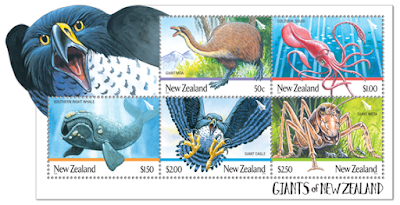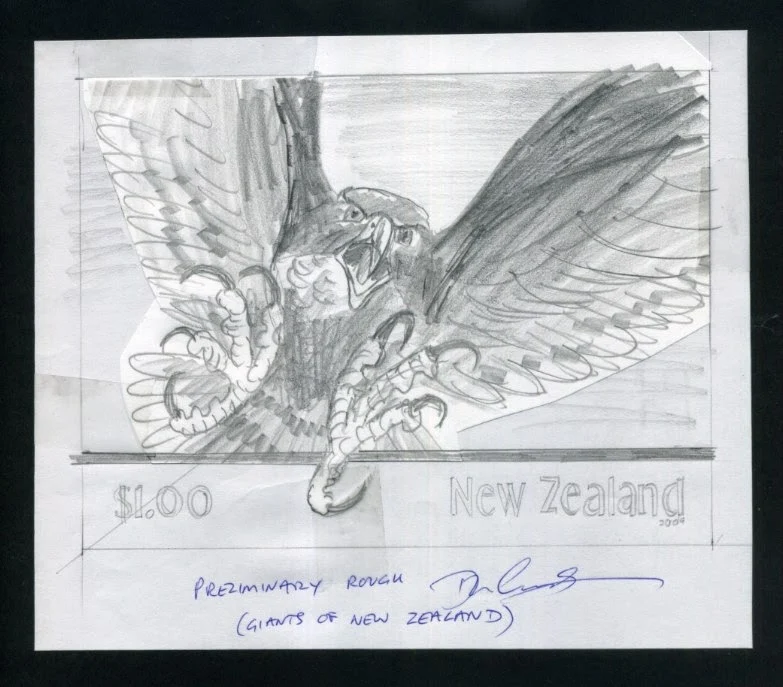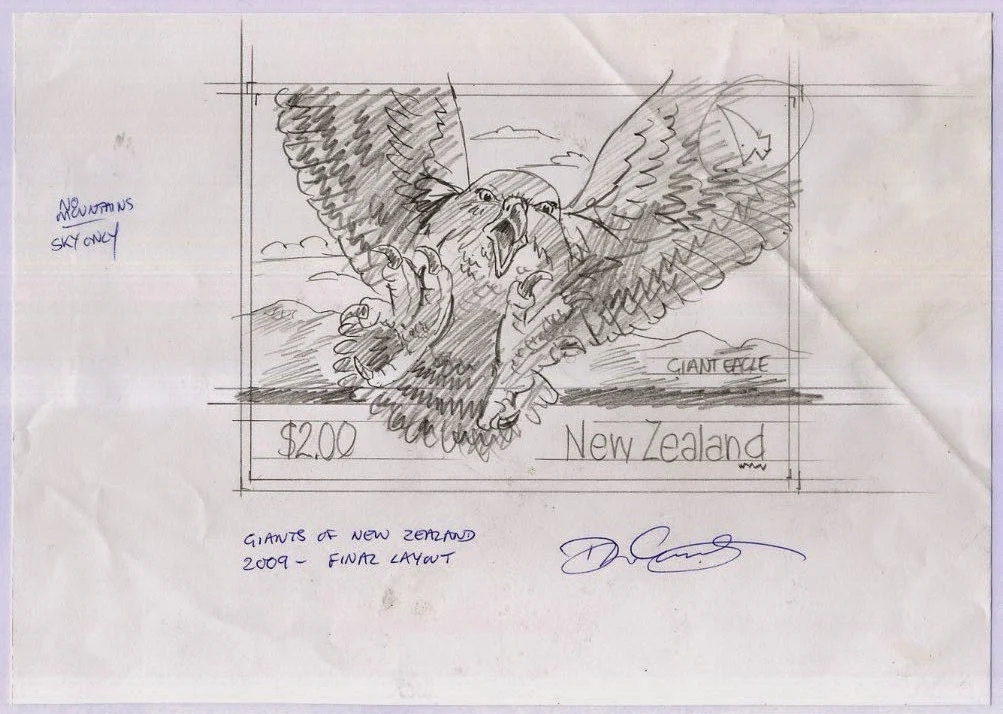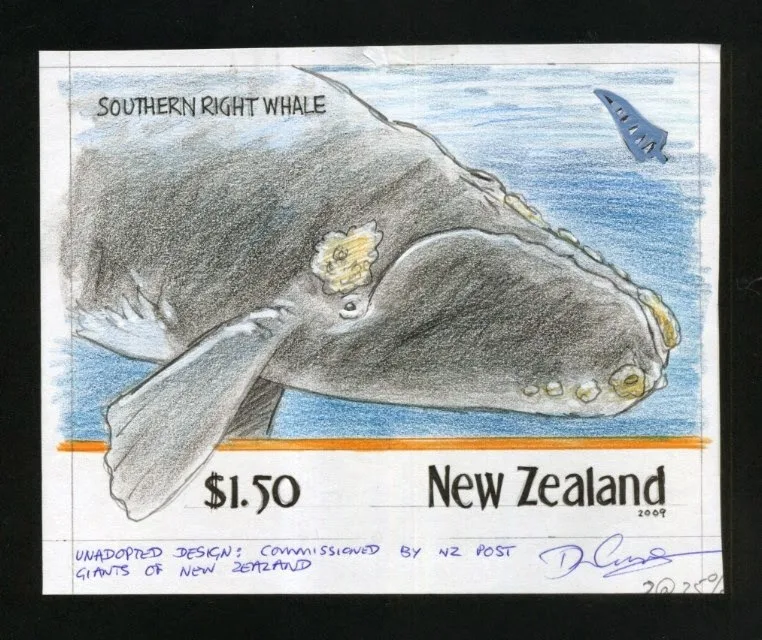 I found an interesting collection of abandoned artwork that had been prepared for the 2009 Giants of New Zealand issue by the designer Dave Gunson, from Auckland. I thought it would make a great subject for this blog. First, we are going to look at the set as issued then we will go through this small collection of artwork trials.
I found an interesting collection of abandoned artwork that had been prepared for the 2009 Giants of New Zealand issue by the designer Dave Gunson, from Auckland. I thought it would make a great subject for this blog. First, we are going to look at the set as issued then we will go through this small collection of artwork trials.The 2009 Giant Issue featured five creatures from around New Zealand, that were extra large for their kind. They were displayed using a cartoon form of drawings on five extra-large postage stamps. Two of the creatures shown have long been extinct while the other three still survive, although they are all on the rare or endangered list.
These are very colourful stamps with their larger format being used to its full potential. Personally, I would have rather seen the drawings being closer to real life, particularly on the Giant Eagle. It appears the design selection for this issue was partly driven by the need to produce stamps that would stand out, almost shock, in their appearance.
The Five Stamps.
50c – Giant Moa.
50c – Giant Moa is believed to have become extinct some 500 years ago. The large South Island Moa was one of the largest birds to exist in modern times. Some say it was driven to extinction by overhunting by the Maori while others say it was caused by a change of habitat that the birds were unable to adapt to.
I think the Moa shown here looks like a large kiwi with a long neck while the skeleton in the Auckland Museum appears to be more upright with a smaller body in proportion to its size and height.
$1.00 – Colossal Squid. $1.50 – Southern Right Whale.
$1.00 – Colossal Squid is a very large type of squid found in the deep oceans between New Zealand and Antarctica. While examples are still believed to exist, they are very rare with the last one being captured by a New Zealand fishing boat off Antarctica in 2007.
$1.50 – Southern Right Whale is a species of whale found in New Zealand waters. Their size and slow speed made these whales easier to catch and they yielded more oil than other whales. For this reason, they got the name Right Whale - ‘the right whale to catch’.
$2.00 – Giant Eagle. $2.50 – Giant Weta.
$2.00 – Giant Eagle is another very large New Zealand bird, believed to have become extinct at about the same time as the Moa. Said to be the world’s largest eagle, with its tiger-like talons and three-metre wingspan, this bird must have truly been an awesome sight.
$2.50 – Giant Weta is one of a number of weta species found in New Zealand. This 10-centimetre-long insect is a peaceful creature that usually eats leaves, flowers and fruit. Of course, its appearance makes it misunderstood, with many people considering it to be very dangerous.
Special Collector Items.
First Day Cover - 4 March 2009.
First day cover with stamps affixed. Cancelled on the first day of issue.
Miniature Sheet.
Miniature Sheet First Day Cover - 4 March 2009.
First day cover with miniature sheet affixed. Cancelled on the first day of issue.
Giants of New Zealand Presentation Pack.
Presentation pack containing a selection of stamp products from the issue, further information on the theme of the stamps and a set of five fridge magnets.
Giants of New Zealand Limited Edition.
Limited edition collectable containing exclusive stamp products not available anywhere else.
Technical Information.
Date of issue: 4 March 2009.
The number of stamps: Five gummed stamps.
Denominations: 50c, $1.00, $1.50, $2.00, $2.50.
Stamps and first-day cover designed: Dave Gunson, Auckland, New Zealand.
Printer and process: Southern Colour Print, Dunedin, New Zealand – by offset lithography.
The number of colours: Four process colours.
Stamp size and format: 52mm x 37.5mm (horizontal).
Paper type: Tullis Russell 104gsm red phosphor gummed stamp paper.
The number of stamps per sheet: 25.
Perforation gauge: 14.4 x 14.60.
Special blocks: Plate/imprint blocks could be obtained by purchasing at least six stamps from a sheet. Barcode blocks were available in both A and B formats.
Period of sale: These stamps remained on sale until close of business 3 March 2010.
Abandoned artwork by the designer Dave Gunson.
This set was designed by Aucklander, Dave Gunson. During the process, a number of designs were produced and abandoned. Below is a collection of some of these. I've tried to provide notes and commentary where I can.
This sketch in pencil was prepared for the 50c value showing the Giant Moa. It is actually very similar to the final design. Also, notice that all of these artwork proofs have been signed by the designer.
A second pencil design was produced using a landscape format. Notice the words "Final Layout" can be seen bottom left.
This drawing was then reproduced in colour as can be seen below.
This artwork for the $2.50 value showing the Giant Weta. When compared to the final design you will notice that this one is in portrait format, being a close up showing just the face. while. A new attempt at this design was made using a landscape design showing the whole body as appeared in the issued stamp. The pencil version of this layout can be seen below.
The two designs, above and below are of a Giant Albatross. There were two pictures were done, one in landscape and one portrait, but it was later decided not to use the Albatross, so all artwork for this was dropped. Notice they still had not settled on the stamp format either.
Now we get to what I consider to be the best part of this post,
is the artwork done on the Giant Eagle.
In this first design, a close view was used of just the eagle's head. The idea was dropped in favour of views of the whole bird. Notice that all of these designs show the eagle appearing on the $1.00 value while with the final issue it appeared on the $2.00 stamp.
Here are two views of a Giant Eagle flying. The Design above was produced first before being redrawn as the design below. Later a further change was made as can be seen in the pencil sketch at the bottom. My personal choice would have been the design above.
This pencil sketch is getting closest to the final design showing a head-on view of the bird. While it turned into a dramatic design I would rather have seen a view of the eagle flying as they are in the two views above this one. Below can be found this same picture, but now shown in a landscape format.
The large Southern Right Whale. This drawing above was one of three here that didn't make the cut with the Post Office. This shows a general view of a whole whale.
This second drawing of the Southern Right Whale shows the head and part of its body.
Another drawing now showing a bit more 'action' with the tail bent up as if the whale is swimming.
The photocopy above is of a suggested design for a First Day Cover. Notice that all the stamps are designs that never made the final selection.
Now the last design in this collection is of the postmark used to cancel the First Day Cover. If you compare this with the one on the actual First Day Cover above, you will notice that they are very similar.
Some of the images in this post were used with permission from the illustrated catalogue of StampsNZ.
You can visit their web site and On-line Catalogue at, http://stampsnz.com/


























This is an interesting page. Where did you find all those old drawings. I wonder that he didn't throw them away when they got rejected.
ReplyDeleteI like that eagle, the same one you do. That is a good picture. Can I have a copy?
Anne.
Thanks Anne.
DeleteThey were on a stamp site. A good collect aren't they.
Allan.
Yes these are an amazing collection of drawings.
DeleteLike you I like that first eagle flying. Eagle 1 I think he wrote on it.
I am enjoying this blog. It reminds me of my home there.
Amanda.
Amanda, I am happy you are enjoying my blog.
DeleteI just hope I am not making you too home-sick.
Allan
We appreciate your engagement with our content. To ensure a respectful and constructive community, please take note of the following:
- No Spam, Please: We do not tolerate spammy or promotional comments. Any such comments will be promptly removed.
- Moderation in Place: All comments are moderated to maintain a positive and inclusive environment. Please be patient, as it may take a little time for your comment to appear.
- Sign In with Google: To comment, please sign in using your Google account. This helps us maintain the integrity of our community and allows for better interaction.